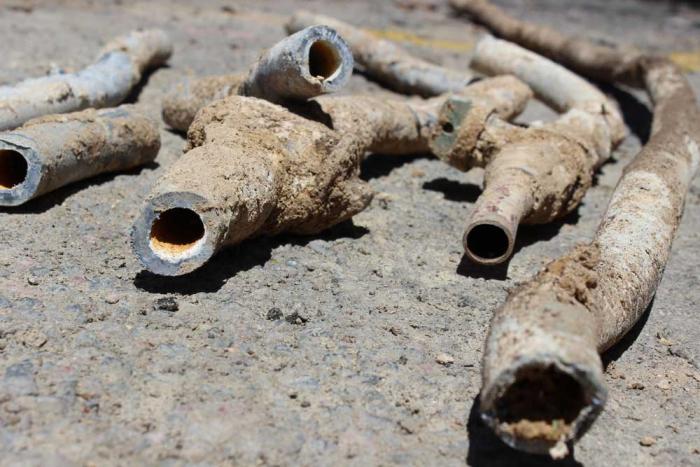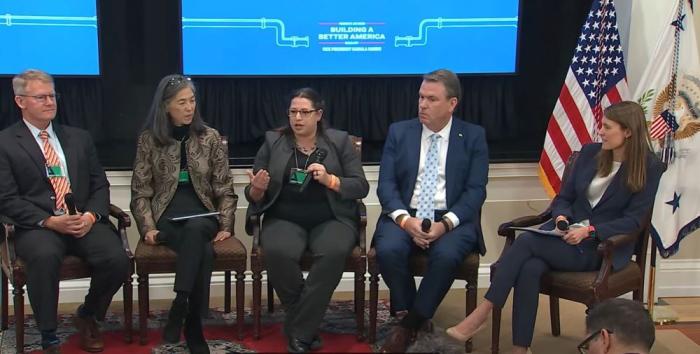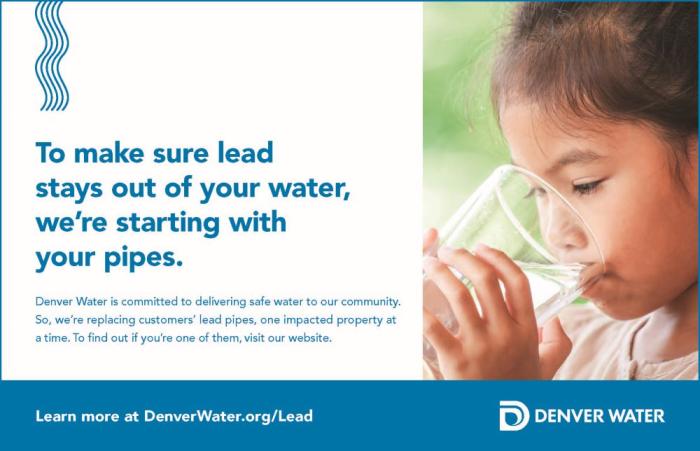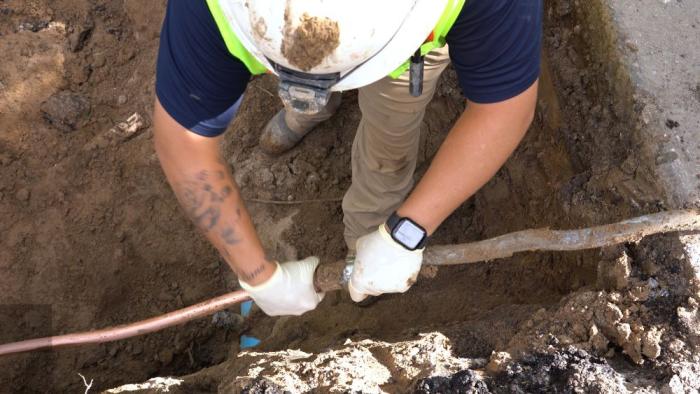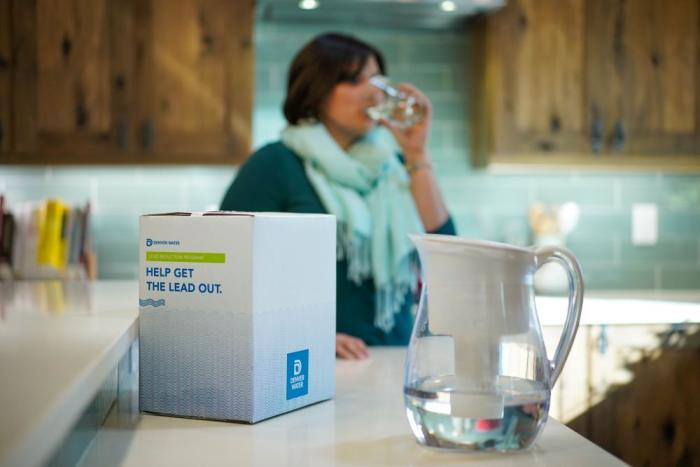More than 15,000 lead service lines have been replaced
Three years into Denver Water’s nationally groundbreaking effort to replace tens of thousands of buried lead service lines that carry water into homes, schools and businesses, it’s the spirit of partnership that strikes Alexis Woodrow.
“We replaced more than 15,000 customer-owned lead service lines in the first three years, and that’s a number that sticks out to people when they look at the program. But Denver Water didn’t — and couldn’t — have done it alone,” said Woodrow, who manages Denver Water’s Lead Reduction Program.
The program’s collaborative approach stretches from state and federal regulators, who reviewed, approved — and continue to monitor — the utility’s work to reduce the risk of lead in drinking water. It runs through the utility’s staff and contractors who shared in the work to implement the program. It knits together community groups that help reach out to customers to explain the program.
And it includes the people living in more than 100,000 households who found themselves enrolled in the newly launched Lead Reduction Program, which started in January 2020.
Learn more about Denver Water’s Lead Reduction Program.
“Because of the partnerships we created, we are able to better protect our customers from the risk of lead in their drinking water and able to replace all those lines. And it was not only due to the number of partnerships we’ve created, but also how lasting and successful they’ve become,” said Woodrow, who in January was invited to speak on a panel at the first-ever White House summit on replacing lead service lines.
While there is no lead in the water Denver Water delivers to customers, lead can get into drinking water as it passes through customer-owned service lines and internal plumbing and fixtures that contain lead.
Denver Water’s Lead Reduction Program is fast-tracking the replacement of the estimated 64,000 to 84,000 customer-owned lead service lines, which carry water from the water main in the street, with lead-free copper lines at no direct cost to the customer.
In addition, the program adjusted the chemistry of the water, created an interactive map showing which buildings might have lead service lines, provided water pitchers and filters to customers to use until six months after their line was replaced —and communicated it all to customers by launching the biggest public health education campaign in the utility’s history.
Top 10 things to know about Denver Water replacing your lead service line.
But the most important partnership is with Denver Water’s customers — who own the lead service line the utility is replacing at no direct cost to the customer, Woodrow said.
“It’s a community benefit on multiple levels, including the jobs that are created, but all this work is focused on the customer, because to replace the customer-owned lead service line we have to go into the customer’s home,” she said.
“People have to understand what is happening and why. And that they are willing to open the door to us, to partner with us to make their families safe and their drinking water safer — that is what makes this program successful.”
A look at the first three years of Denver Water’s Lead Reduction Program, from January 2020 through Dec. 31, 2022.
By the numbers:
More than 6.72 million — The number of contacts the program made with customers enrolled in the program using mail, phone calls, digital outreach, in-person events and virtual meetings since January 2020.
Providing resources and information in both Spanish and English allows the utility to reach more than 95% of the households in the program in their primary language.
15,427 — The total number of customer-owned lead service lines replaced in the three years between January 2020 and December 2022. Of that, 5,119 lead lines were replaced in 2022. (Denver Water has surpassed the annual requirement of 4,477 lines replaced in each of the first three years of the program.)
588,000+ — Number of page views at denverwater.org/Lead, the program’s website, since January 2020, including the Spanish language version of the site, denverwater.org/Plomos that launched in October 2021.
83% — The number of customers enrolled in the program reporting they used filtered water for cooking, drinking and preparing infant formula. Denver Water provides customers enrolled in the program with water pitchers and filters certified to remove lead (plus replacement filters every six months) to use until six months after their lead service line is replaced.
65,600+ — The number of free water test kits supplied since January 2020 to customers to collect and return water samples from their homes to be tested for lead at no cost to the customer. Information from these test results help Denver Water know which buildings have — or don’t have — lead service lines that must be replaced.
8.8 — Maintained the pH level of the water that Denver Water delivers to customers within a very small range of 8.8 on the pH scale, reducing the potential for lead to get into drinking water by strengthening an existing protective coating in customer-owned service lines, household plumbing and fixtures.
95%+ — The level of support the program receives from surveyed customers for the goal of replacing all lead service lines and the importance of the program to the well-being of the community.
The numbers are even more impressive when accounting for the timing. The program launched just as the COVID-19 global pandemic was taking hold.
With in-person neighborhood meetings no longer an option, communication efforts shifted to virtual presentations on calls that attracted thousands of listeners. In the early days of the program, crews shifted to replacing lead service lines in businesses that were temporarily closed due to shutdowns.
Regulators also have reviewed the program’s first three years, and in 2022 gave their go-ahead to continue the program under updated federal regulations surrounding lead in drinking water that are expected to take effect in 2024. Those regulations are more in line with Denver Water’s Lead Reduction Program and will require utilities across the nation to increase their focus on removing lead service lines.
“We’ve learned so much in the last three years, about communicating, about our customers, about replacing lines — and also about maintaining the pH of the water, changing the water chemistry to protect our customers and doing it from the treatment plants all the way to the customers’ tap,” Woodrow said.
“That’s an unseen but incredibly important part of this program, and Denver Water’s water quality and treatment team has done it. We’ve seen a reduction in lead levels in homes where we know there’s a lead service line because of that work.”
So, what’s next?
In 2023, the pace of replacement work will pick up due to an infusion of $76 million in federal funding the program received last year.
The federal money will be spent through 2025 and is expected to help pay for replacing up to 7,000 lines, shortening the 15-year program by about 1.5 years. Thanks to this additional funding, up to 3,000 additional lines will be replaced in 2023 — on top of the nearly 5,000 lines already planned for replacement during the year.
“The federal funding allows us to accelerate the program and also reach areas that are more difficult to do replacements on due to construction constraints — because the buildings are on bigger roads or important arterials, or they’re multifamily homes or there are paving moratoriums on the street,” Woodrow said.
Customers can expect the program to be more visible in the next few years, as crews will be in more neighborhoods and on more visible streets, Woodrow said.
More crews will be tasked with investigating pipe material, which involves drilling small holes (called potholes) in streets and yards to shine a flashlight on the service line to actually see if the pipe is made of lead — or not. Results from this work are fed into the machine learning model that helps plan where replacement work should take place in the future.
Denver Water’s Alexis Woodrow discusses “Partnerships on Lead” during the first-ever White House summit on Accelerating Lead Pipe Replacement. (The panel starts about 90 minutes into the summit.)
She also expects the program will be communicating more with businesses along the larger streets where replacements are taking place.
“We will be working with the businesses and doing outreach to do what we can to minimize the impacts to them where we can as the replacement work is done,” Woodrow said.
And with the continued support of Denver Water’s leadership and commissioners, the program will continue to look for opportunities for additional funding to keep the replacement pace moving forward as fast as possible.
“This program’s goal is to replace all lead service lines in our service area. And we’ll continue to do this work until they’re all replaced,” Woodrow said.


